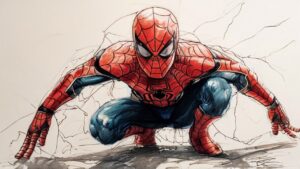
Art has always been a profound means of expression, transcending barriers of language, culture, and time. Among its many forms, abstract art holds a unique place, allowing artists to convey deep emotions and complex ideas through seemingly simple forms. One intriguing concept within abstract art is “Drawing:yw-tzomiaao= Heart”, which combines abstract creativity with symbolic representation. This article delves deep into this unique drawing approach, exploring its origins, techniques, emotional resonance, and contemporary relevance.
Table of Contents
Examining “Drawing:Yw-Tzomiaao= Heart”: An Inquiry into Symbolic Representation and Abstract Creativity
Though it might not seem recognizable, “Drawing:yw-tzomiaao= Heart” has important connotations in contemporary art. This phrase is said to have originated from a fusion of several cultural influences and creative traditions, while not being included in traditional dictionaries. “Drawing:yw-tzomiaao= Heart,” which has its roots in abstract expressionism, highlights the artist’s impromptu and subconscious creative process. Rather than accurately portraying the outside world, the goal of the art form is to arouse feelings and stimulate the mind.
The symbol “Drawing:yw-tzomiaao= Heart” represents a link between the emotional and abstract domains. It implies that the heart, both as a real organ and as a symbol for human emotions, is captured in the painting.
Methods and Approaches
Many creative approaches are used in the drawing of “Drawing:yw-tzomiaao= Heart,” which enhances both its visual and emotional effect.
Line Work in Abstraction:
Abstract line work is the fundamental element of Drawing:yw-tzomiaao= Heart. Flowing, linked lines are used by artists to create shapes that suggest energy and movement. These lines, which portray many facets of the human experience, might be powerful and aggressive or delicate and airy. Viewers are encouraged to find personal significance in the artwork because of its abstract form, which lends itself to many interpretations.
Symbolic Illustration:
Yw-Tzomiaao artwork are heavily symbolic, with the heart acting as the main theme. Using either conventional iconography or abstract forms, artists portray the heart and then skillfully incorporate it into the larger picture. By serving as an anchor, the symbolic heart grounds the abstract components in a relatable and intensely felt idea. One intriguing concept within abstract art is “Drawing:yw-tzomiaao= Heart”, which combines abstract creativity with symbolic representation.
Texture and Color:
In order to further enhance the emotional depth of Drawing:yw-tzomiaao= Heart artworks, color and texture are essential elements. Artists might emphasize form and line using a monochrome palette, or they can elicit particular feelings with vivid colors. Textural components like stippling and cross-hatching give the artwork depth and intricacy while also producing a tactile visual experience that appeals to the viewer’s senses on several levels.
Sensitivity to Emotion and Interpretation
The capacity of “Drawing:yw-tzomiaao= Heart” to arouse a variety of emotions and encourage many interpretations is what gives it its actual power:
Reflection and Introspection:
Reflection is prompted by the Drawing:yw-tzomiaao= Heart complex and frequently disorganized line work. The artwork’s intricacies captivate viewers, inspiring them to consider their feelings and ideas. As a center of attention, the heart motif directs reflection toward topics of vulnerability, love, and compassion.
Relationship and Empathy:
The heart’s global meaning encourages viewers to feel connected and empathetic. One intriguing concept within abstract art is “Drawing:yw-tzomiaao= Heart”, which combines abstract creativity with symbolic representation. The symbolism of the heart may connect with audiences regardless of language or cultural barriers, creating compassion and solidarity.
kinetic energy:
Drawing:yw-tzomiaao= Heart have a natural fluidity that exudes a feeling of dynamic energy. A sense of vigor and exuberance is evoked by the flowing lines and brilliant colors, encouraging viewers to follow their emotions and express themselves freely.
The Process of Creativity
Making a Yw-Tzomiaao drawing is about the process as much as the finished product. Artists frequently characterize this process as cathartic and contemplative, with many crucial stages involved:
Getting Motivated:
Drawing:yw-tzomiaao= Heart can take inspiration from a variety of sources, including abstract ideas, music, nature, and personal experiences. Due to the abstract nature of the medium, artists are free to delve into their subconscious and produce one-of-a-kind works that speak to both universal and personal themes.
First Drawing:
Loose, flowing drawings are usually the first step in the creative process. Using these opening lines, artists lay the groundwork for their composition, letting their hand be guided by intuition and spontaneity.
Adding and refining information:
Artists polish their work by experimenting with colors and textures, adding details, and changing the line weights as the drawing develops. One intriguing concept within abstract art is “Drawing:yw-tzomiaao= Heart”, which combines abstract creativity with symbolic representation. The composition carefully incorporates the heart theme to make sure it complements the abstract aspects.
Last Minute Details and Presentation:
Putting the finishing touches and getting the artwork ready for display are part of the last step. This might entail framing the work, taking a digital media snapshot of it, or getting it ready for public exhibition. The objective is to produce a unified and powerful piece of art that appeals to viewers’ senses both viscerally and emotionally.
Yw-Tzomiaao in Today’s Creative Works
Beyond conventional media, Drawing:yw-tzomiaao= Heart impact may be seen in a variety of modern art genres, including:
Technology and Digital Art:
Technological developments in digital art have given Yw-Tzomiaao additional opportunities. By experimenting with various textures, colors, and effects, artists may create complex and dynamic compositions that push the boundaries of abstract expressionism thanks to digital resources. Additionally, the digital media makes it simpler to share and distribute artwork, instantly reaching a worldwide audience.
Murals & Public Art:
Yw-Tzomiaao’s flowing, abstract lines have transformed urban settings, and she has found a home in murals and public art. Large-scale works enhance surroundings, stimulate public participation, and allow for interpretation, all of which promote a feeling of shared experience and community.
Learning the Technique of Artistry in Motion Drawing
Comprehending the Idea:
Gaining a firm grasp of the fundamentals of the Artistry in Motion sketching style is the first step towards mastering it. The main goal of this method is to convey fluidity and dynamic movement on paper. By utilizing lines, forms, and composition, it seeks to evoke a sense of motion, energy, and rhythm. Artists that use this method place emphasis on lines that are continuous and flowing, suggesting motion and direction.
The dynamic composition is essential because it places the pieces in a way that evokes motion and energy while also creating a visual rhythm. Furthermore, gesture is very important since it is the process of using swift, expressive strokes to capture the essence of movement and activity. To achieve the intended impression, it is important to preserve harmony within the composition while balancing these parts.
Examining Gesture and Movement:
Studying real-world item and human movement is essential to developing Artistry in Motion. The mechanics of movement are better understood by artists through observational sketching sessions that center on people, animals, and objects in motion. Here, gesture sketching becomes a crucial technique that enables artists to rapidly and accurately represent the essence of movement and gesture. Artists may communicate energy and rhythm through dynamic lines and streamlined shapes by practicing gesture sketching.
Exercise Your Sketching Gestures:
To become proficient in the Artistry in Motion approach, practice is essential. Drawing motions and fast stances at first helps artists convey movement and fluidity in their work. Instead of paying close attention to minute details, artists capture motion and energy in brief postures that last anywhere from thirty seconds to several minutes. Drawings with varied degrees of movement and energy may be conveyed by experimenting with different sorts of lines, such as curving, flowing, and angular lines. Their comprehension and ability to effectively represent motion are further expanded when they draw a variety of topics, including people, animals, and objects in motion.
Playing with Perspective and Composition:
Dynamic compositions and perspectives that heighten the impression of movement in a drawing are common components of artistry in motion. Foreshortening is a technique used by artists to express depth and dimension, which is especially helpful when depicting action from unusual angles. To fully represent the breadth of human movement, dynamic positions including twisting, jumping, and stretching figures are investigated. Effective use of the foreground and background components increases the composition’s overall dynamic and provides depth.
Growing in Interpretation and Style:
Artists are encouraged to develop their own style and interpretation of Artistry in Motion while learning the method. One of the main ingredients in producing original works of art that convey the artist’s feelings and vision is personal expression. Artists can determine which drawing media best conveys the dynamic element of motion in their work by experimenting with various drawing tools and materials, such as charcoal, ink, and digital. Getting input from mentors or peers helps them hone their craft and create a unique artistic voice that makes their work stand out.
Iteration and ongoing learning:
Learning and developing continuously is the goal of mastering artistry in motion. To hone their talents, artists set aside regular time to practice creating dynamic compositions and drawing motions. Continuous progress and artistic development are fostered by accepting mistakes as learning opportunities and pushing limits with new themes, compositions, or views. Examining the works of accomplished painters who are renowned for their command of motion and dynamic composition offers ideas and insights into various methods for successfully depicting movement.
Artists may become proficient in the Artistry in Motion sketching approach and produce works of art that eloquently capture the energy, rhythm, and fluidity of motion by adhering to these organized processes and making a commitment to continuous practice and research.
Concluding
To sum up, “Drawing: Yw-Tzomiaao = Heart” is an amalgam of symbolic representation and abstract inventiveness that provides both spectators and artists with an in-depth examination of feelings, ideas, and the human condition. Its adaptability and capacity to arouse strong emotions guarantee its ongoing significance and development in the ever-changing field of contemporary art. With its expressive strength and worldwide appeal, Yw-Tzomiaao never fails to capture and inspire, whether it is on canvas, digitally generated, or decorating city walls.
READ MORE






